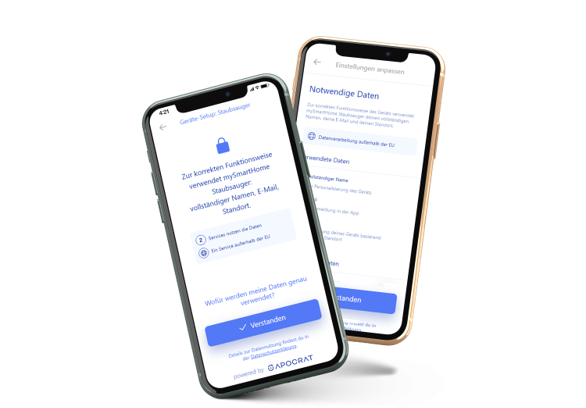APOCRAT's demo version allows a first-hand look at a privacy-compliant future. Matching the three components of our solution, our demo version invites you to quickly and easily get to know APOCRAT's Consent Management Platform in three parts. To make the best use of the demo, this blog post introduces the main features step by step.
APOCRAT's Web Platform
Part 1 of the demo version is our web platform. It is the heart of our Consent Management solution and is designed for the administration of settings and the management of data.
In the first step, service categories are created. Each customer is free to choose or create these categories for their products. Service categories are already known to many device users through cookie banners on websites and range from personalized advertising to necessary data and device optimization.

Demo - Service Categories
After the service categories are created, they are assigned to one or services. For example, Google Advertising Products are assigned to the service category marketing. In order to enable device users to make an informed decision about agreeing to or rejecting a service, the very service is assigned additional information. This information includes the purpose, owner, domains used, or the data collected for the service in question.
In the second step, one or more Consent Sets are being created. A Consent Set consists of one or more Consent Screens, each of which is assigned to a service category (step 1). Consent screens are APOCRAT's only point of contact with device users, who can give or withhold their consent to data processing. Therefore, APOCRAT focuses on a clear, simple and, above all, legally compliant basic design. The Consent Screens can be fully adapted to the setup process of the smart devices in the customer’s app.

Exemplary Consent Screen for Service Category "Necessary Data"
In order to create a Consent Set, the layout of the Consent Screens must be defined. Among other things, the images, headlines or designs used for the screens are decided, which are then displayed on the app of the device user via the App SDK. The App SDK is a software development kit that is implemented into the code of the smart home app, which is used to control the devices. For the use of our demo version no SDK is required, since a system has been set up for this purpose. This setup allows our potential customers to get a quick and easy overview of our solution. Once the design of all the Consent Screens is defined, the Consent Set is complete.

Demo - Consent Set
In the third step, product categories are set up. Product categories mean general classifications of products such as household appliances, safety devices or toys. Each category is then assigned a Consent Set (step 2) containing the Consent Screens created for it. For each product created in a category, the previously made settings are automatically adopted, unless specific settings are made separately for a certain product. The automatic transfer of settings in a category is recommended if several products, such as smart refrigerators and washing machines in the household appliances category, use the same services.

Demo - Product Category
In the fourth step, products (e.g. smart refrigerator) and their associated models (e.g. model E12 and E17) are added. Once this step is completed, the IoT SDK can be downloaded. The IoT SDK is the second element of the SDK set that every APOCRAT customer receives. The IoT SDK is implemented in the software of the smart home devices. Consequently, the rules set by the device users on the Cosent screens can be implemented. Once again, the IoT SDK is not needed for our demo version.
In the fifth step, it is worth taking a look at the Device Overview. This shows which devices have already communicated to the web platform of APOCRAT. The smart home devices communicate with the web platform to retrieve the Consent Rules set by the device users. If a device has not accessed information from the platform for more than one month, it is marked as inactive.
The sixth step is simply to specify which operating system (e.g. Android) and its minimum version (e.g. Android 10) the app uses to control the devices. Once this is done, the SDK for the implementation can already be downloaded.
In the seventh and last step of Part 1, the reporting function can be tested. A report can be created on the respective device category, product or model as needed. Once the selection is made, only a time period needs to be specified. The report thus created will include statistics on the consent rate for a specific service or data on the time of consent or its revocation, among other things.
Components Two and Three
Now that the necessary settings have been made, Parts 2 and 3 are used for visualization. Part 2 shows how the consent screens created on the web platform are displayed on a test application. The consent rules chosen via the screens are then forwarded to part 3 of the demo. This is a virtual simulation of an IoT device that shows how the settings are implemented.
Smart home companies, as a result of new laws and regulation, are under strict obligation to let their customers determine how their data is used and to implement the settings made as a consequence. The industry is thus facing the biggest data protection challenge since the entry into force of GDPR in 2018. APOCRAT's demo version offers companies a first and non-binding step towards a legally compliant future, where penalties need not be feared, one's brand is strengthened, trust is built with customers, and the full potential of the collected data can be used. Feel free to contact the person listed below or send a request via "Become a Partner" here on our website to test our demo version with the assistance of a team member.
Contact
Partner & Sales Manager: Alexander Jürgens
E-Mail: office@apocrat.at
Mobile: +43 676 4025255
